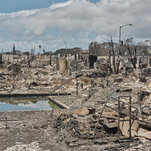
Photos: A Journey Through the Destruction From the Fires in Lahaina

Along the empty streets of Lahaina, the warped shells of vehicles sit as if frozen in time, some of them still in the middle of the road, pointed toward escapes that were cut short. Others stand in driveways next to houses that are now piles of ash, many still smoldering with acrid smoke.
A few agitated myna birds chirp from their perches on palm trees that have been singed into matchsticks, the carcasses of other birds and several cats scattered below them in the streets.
Across the town that was once home to 13,000 people, residents are slowly returning and sifting through the debris of their homes, some of them in tears, finding little to salvage.
In a neighborhood along the burned hillside, Shelly and Avi Ronen were searching the rubble of their home for a safe that held $50,000 of savings, left behind with the rest of their belongings when they fled the fire. They considered themselves lucky to have made it out at all: A man just up the hill did not survive, and neighbors told them that several children who had ventured outside to get a look when the fire was approaching were now missing.
“A lot of people died,” Ms. Ronen said, her voice breaking. “People couldn’t get out.”
Image

Image
Image
As she spoke, her husband emerged from the rubble of the house with the safe in his hands, seriously charred, but intact. There were no signs of the key, so he bashed it with a rock until it broke open.
Inside it was a pile of ash.
In the wake of the fire that tore with stunning velocity through Lahaina this week, killing at least 67 people, much of the small, historic town was cut off for days from the rest of the island of Maui by downed power lines and police checkpoints. It sat in lonely desolation, the houses uninhabitable, the search for victims slowed by a lack of personnel and a growing conviction that no one would be found alive.
For centuries, Lahaina has been a focal point of Hawaiian history and culture, a former capital of the Hawaiian Kingdom and a booming center of modern tourism that had managed to preserve its old-world charm. It was home to both vital relics that connected people to the island’s Indigenous history and a downtown of island-chic art shops and restaurants with astonishing views.
Now those treasures are gone, replaced by scenes that locals and officials have repeatedly likened to a war zone. As residents return to their homes, some are making reluctant but unavoidable plans for life elsewhere. With more bodies likely to be found as the searches continue, their town has become the scene of one of the nation’s deadliest wildfires of the past century.
Image
Image
It had all happened so fast, residents said. A brush fire on Tuesday morning had been contained, but then fire flared up once again in the afternoon. Stoked by hurricane-force gusts of wind, it was soon rushing down the hillside through town, tearing across a drought-parched landscape with little to stop it until it reached the ocean.
At the shoreline, where the fire had run out of room, waves lapped up to beachfront properties that had few discernible features of a home — a singed mailbox, a metal gate, a water heater poking up through the debris. An orange cat slipped out from behind the husk of a vehicle and then darted away.
A man could be seen pedaling his bike near the waterfront, checking on the homes of people he knew. With no power and limited cellphone coverage, he did not how many people had died. When he learned it was in the dozens, he grew emotional, looking upward and blinking back tears.
Several blocks to the north, past the school buildings gutted by flames, the town’s prized banyan tree sat wounded, its leaves curled and crispy. Sitting alone below its inadequate shade was a man named Anthony Garcia.
When the fire began raging, some people had only minutes to flee, jumping into cars or simply running as fast as they could as the inferno spit embers onto their necks.
Image
Image
Image
Mr. Garcia, 80, said he had been eating chips and salsa and sipping on a beer in a local restaurant when smoke suddenly began to billow through town. He made it back to his apartment to grab medications but then ran out of time. He sought refuge on a nearby baseball field. For what seemed like hours, he lay face down in the dirt, his throat burning, his skin baking. “It was like a sandstorm of heat and embers,” he said.
Somehow, the fire spared him. But with his apartment and all his belongings gone, he has been sleeping outside, unsure of where to go.
“I really don’t know what I’m going to do,” Mr. Garcia said. “I’m in God’s hands.”
On nearby Front Street, a small group of firefighters and work crews were moving debris to clear the roadway, but few were navigating through the broad devastation further east. Many there said little help was being sent; locals had taken matters into their own hands, shuttling in water bottles in pickup trucks and gas by boat. Some drove cautiously through the streets, offering food or aid to those in need.
In the Lahainaluna neighborhood along the hillside, Lanny Daise, 71, pulled up to the house that had been built by his wife’s grandfather decades ago. Now it was a pile of twisted metal atop a charred foundation. As he navigated the debris, he kept stopping, sighing and taking photos on his phone. Nothing was salvageable, save for a couple of wrenches.
Image
Image
Two blocks further up, Benzon and Bella Dres were hunting for jewelry and not having any luck. Their rented house was gone and they had lost everything. Ms. Dres was wearing a pink shirt given to her by a manager at the hotel where she worked. For now, they were staying at another hotel where Mr. Dres worked, but, with no money or belongings, they were uncertain of the future. Eventually, they stopped searching.
“Everything’s gone,” Ms. Dres said.
As they drove away, traveling past downed power lines, Felina De La Cruz and her family were arriving at a house nearby, a property with multiple units that was home to 17 people from four families. Ms. De La Cruz said that when they moved from the Philippines to Lahaina two decades ago, they knew upon arriving that it was where they wanted their home to be. It was a community where everyone took care of each other, she said.
The neighborhood, perched on a hillside with a picturesque view of the town, the waterfront and the sunsets beyond, had a different view now: Ms. De La Cruz looked out on nearly a mile of charred homes below, the smoke still rising into the sky and casting a haze over the town.
Nothing was clear. With no belongings and no permanent place to live, it was a mystery where she and her husband would go with their three children. When would anyone be able to live here again?
“It’s so, so sad,” she said. “I love this place. I love Lahaina. I want to live here. But, I don’t know.”
A version of this article appears in print on , Section
A
, Page
1
of the New York edition
with the headline:
A Town Is Left With Just Ash And Anguish. Order Reprints | Today’s Paper | Subscribe
Source: https://www.nytimes.com/2023/08/11/us/lahaina-fire.html
















